Vauxhall Opel Astra F
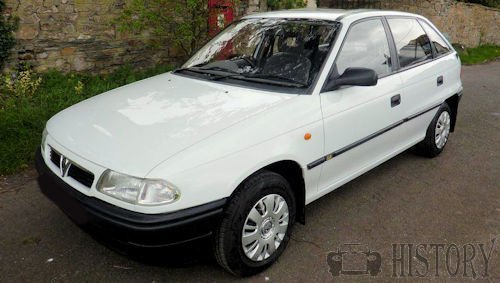 |
|
|
Also called |
|
|
Production |
1991–1998 (Opel) |
|
Body style |
3 and 5-door hatchback |
|
Platform |
T-body platform |
|
Engine |
|
|
Transmission |
5-speed manual |
|
Wheelbase |
2,517 mm (99.1 in) |
|
Length |
Hatch: 4,050 mm (159.4 in) |
|
Width |
1,696 mm (66.8 in) |
|
Height |
1,410 mm (55.5 in) |
The Astra F built from 1991 to spring 1998 (convertible to early 2000) By the car manufacturer Opel. This is the successor to the Opel Kadett E and the sixth model in the series Kadett and Astra.
History
With the introduction of the Astra, the traditional model’s name Kadett was replaced. This happened because in the 1990s Opel replaced all previous model names with artificial names that ended in " a " (such as Vectra, Omega and Calibra) during model changes. The new name should build a new, positive brand image. In surveys Astra was mostly associated with technology and space. The letter indicating the model, however, was continued, which is why the first Astra model, as the official name Astra F.
First, from August 1991, the three and five-door hatchback models available, while the five-door estate followed in October 1991. In May 1992, the classic notchback sedan arrived. The Cabriolet, which was designed like the open Cadet E at Bertone, completed the program by August 1993.
The Astra F are known for a recall because of design flaws on the tank as well as the excessive rust, resulting from processing defects in the production. Other shortcomings such as weak timing belts, ignition distributor malfunctions or the alternator on the Astra F of the first series required frequent workshop visits. A model revision in August 1994 However, a better rust protection precautions have been taken. On request, the Astra F was also available with a 4-speed automatic transmission from the Japanese manufacturer Aisin AW.
The Astra F had a factory-wide range of active and passive safety features. Constructive measures on the body were computer-calculated stiffening points and double-tube reinforcements in the doors. In addition, the columns, the side skirts and the door shafts were reinforced. The body was thus very torsion-resistant. From the beginning belt buckle tensioners and height-adjustable seat belts were fitted as standard. The seat ramps were designed to prevent diving under the belt in a frontal collision. For the front seats frame headrests were offered, these allowed a good view to the rear and prevented in a collision neck injury of the rear passengers. From the spring of 1993, a driver's bag was also offered for a surcharge.
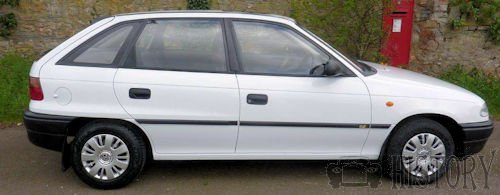
The revision in August 1994 changed some details. For example, the shape of the mirrors (previously corresponded to those of the Kadett E), the door handles (from the end of 1995), the grille, headlights (tapering towards the grille), fog lights (clear glass), the side bumper, rear bumper and the roof spoiler. Compared to the model built until 1994, the plastic part of the bumper, painted in body colour on request, was now limited to the narrow upper edge. The hatchback, the same plastic panel of the GSi was installed until 1994, which was mounted in a similar form from then on also notchback and convertible. From the facelift, all Astras as Opel’s were provided with chrome logos and three-dimensional emblems on the tailgate. The use of white indicator lenses front and tinted four (saloon, convertible, estate) or five-chamber tail lights (hatchback) made the Astra look more modern.
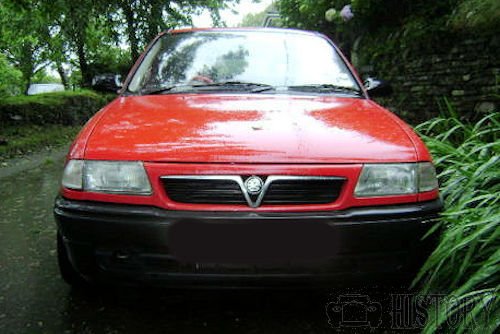
The double airbag (driver 67 litres, passenger 120 litres) was except the export models from August 1994 also series. In addition, the simple info display with clock / radio display (DID) has now been replaced by one with additional outside temperature indicator (TID), which warned of road slipperiness from 3 ° C downwards, for a few seconds Turning on the ignition blinked. It is also possible to read the speed in the TID by pressing both buttons for about five seconds (it displays up to 53 km / h, then '+53 km / h).
Other technical changes in addition to some environmentally friendly engines in the context of the facelift and then the change from oil to gas shock absorbers and thus better handling, modified wishbone front, modified coupling rods, modified suspension of the silencer (from mid-1996; directly on the silencer welded three-point recording similar to the GSi 2.0 16V until summer 1994), modified attachment of the front door panel (one instead of two screws under the armrest, from autumn 1996), gear knob corresponding to the Astra G.
In the convertible with the facelift, there was next to the C20XE engine (which was installed until the model year 1997 as a top engine, but then was removed due to new emission standards from the program) the X20XEV engine, which was now as the Ecotec. This engine replaced the C20NE in the engine range of the estate.
with the facelift in August 1994, the double airbag was installed in all models as standard. ABS was available from the beginning of production at an additional cost, from model year 1996 it was standard. In the Cabriolet the windscreen frame and the two doors were provided with tubular steel reinforcements and the headrests in the Fund also made of steel, in order to ensure the necessary survival space (imaginary line between windscreen frame and headrests) in a rollover.
In March 1998, the successor Astra G was introduced, whereby the production of the Astra F was completed. Only the convertible continued until January 2000. The Astra F Classic was built until July 2002 in the Gliwice plant (Poland) built, there is an "Eastern European" version of the Astra F, which is a mixture of first-run and the facelift. From August 2002 there ran the successor Astra G as Astra Classic II.
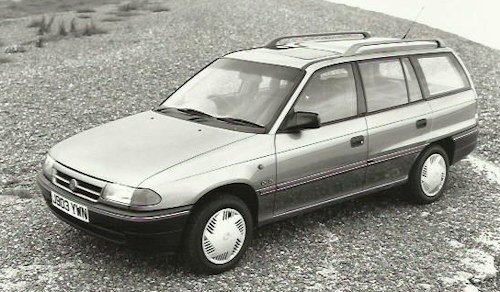
Worldwide
The Astra models were sold in England as Vauxhall, in South America as Chevrolet and in Australia as Holden. In South Africa, only the notchback sedan as Opel Astra, the hatchback models continued to be offered as Opel Kadett. In South Africa, where it was produced under licence by Delta. The "Kadett" name was retained for the hatchback Astras until 1999. South African Kadett ranges featured 140, 160i, 180i and 200i models. The South African Astra included a variant with a 2.0 L turbocharged engine called the Opel Kadett 200t S. The 200t S was a specific name where Delta Motor Corporation wanted to show the specialty of the type. The engine (C20LET) in the Opel Astra 200t S was sourced from the Opel Calibra and Opel Vectra A 4x4 2.0 16V turbo, four-wheel drive found in European markets, but local engineers converted the six-speed, four-wheel-drive drivetrain (Getrag F28) to front-wheel drive only and as such it was unique to South Africa. The Opel Astra also became available in Australia badged as a Holden, first in New Zealand in 1995, and then Australia in 1996. The first models were imported from the UK, but later models were imported from Belgium. The Holden Astra name had previously been used on rebadged Nissan Pulsar models from 1984 to 1989.
Body variants
The Astra F was offered in five body shapes:
- Hatchback with three or five doors with 350 to 1200 l cargo space
- Saloon with four doors
- Estate (caravan) with five doors and the same wheelbase as the other models. A three-door model, as it was still present in the previous model Kadett E, was no longer produced due to low demand. The caravan has a roof antenna compared to the other models. Noteworthy is the trunk, which already holds 500 litres in non-folded rear seats. With the rear seats folded, the luggage compartment even holds 1630 litres. As with all Astra F models, the rear seats are asymmetrically divided, and in conjunction with the absolutely flat cargo bed, the best possible charging flexibility has been achieved. For a surcharge, a through-loading was offered at the centre armrest, this was later in the model "Dream" and "Style" series. The Astra Caravan 1995 was the best-selling station wagon of all classes.
- Cabriolet: The convertible variant of the Opel Astra F was designed by Bertone on the basis of the notchback model. The collapsed fabric roof had no body-own top compartment cover, but had to be covered manually with a cover by means of snaps. Hardly any driver has kept to it because of the complicated handling. The optional anti- theft alarm had the shortcoming that it triggered the alarm when the vehicle was parked open when moving in close proximity.
- Delivery van (Lfw): Caravan without roof railing with three instead of five doors, two seats, sheet metal instead of rear side windows and half-height sheet metal partition behind the seats. The van therefore had a truck approval and was therefore very popular with craftsmen.
- Special forms and special conversions: The Astra Caravan have been modified, among other things, to the long-wheeled hearse and as a disabled-accessible high-roof transporter. The special feature of the wheelchair transporter is that the wheelchair user drives into the passenger compartment via a lowerable aluminium ramp. However, the rear seats are omitted and the tank is located behind the left back door. The inner height is about 140 cm. However, the wheelchair user needs a driver, but he has his own windshield with windscreen wipers.
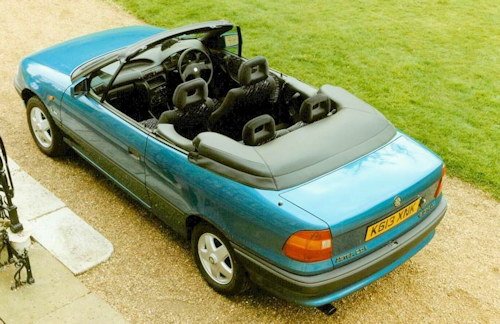
Technical
-
Opel Vauxhall Astra F Technical details and specifications (1991-2000)
Colours
The Astra F was offered in the following colours (colour code in brackets):
Uni
Casablanca white (474)Uni
Pineapple Yellow (485)Uni
Atlantis Blue (285)Uni
Magmarot (547)Uni
Cosmos Blue (204)Uni
Toscanarot (567)Metallic
Caribbean Blue (277)Metallic
Canyon Red (321)Metallic
Heliotrope (279)Metallic
Rio Verdigrün (369)Metallic
titanium silverMetallic
Starsilver I (138)Metallic
Diamond Silver (148)Metallic
Marseille (549)Metallic
graphite (363)Metallic
antelope (490)Metallic
Lavender (292)Metallic
brocade yellow (488)Metallic
champagne (489)Metallic
Smoke Gray (140)Metallic
Nova Black (266)Metallic
Spectral Blue (270)Metallic
ceramic blue (286)Metallic
Magnetic Blue (288)Metallic
Neptune Turquoise (357)Metallic
Bermuda Green (366)Metallic
Lagoon Blue (271)Engines
The Opel Astra F was offered with the following engines:
Petrol engines
model
cylinder
capacity
Power at 1 / min
Torque
Nm at 1 / minengine id
emission standard
construction time
1.4 S 1
4
1389 cc
55 kW (75 hp) / 5800
110/3000
14NV
08 / 1991-07 / 1994
1.4 i
4
1389 cc
44 kW (60 hp) / 5600
103/2600
C14NZ
E2 (taxed after Euro 1)
08 / 1991-08 / 1996
1.4 i
4
1389 cc
44 kW (60 hp) / 5200
103/2800
X14NZ
Euro 2 / D3
09 / 1996-02 / 1998
1.4 Si
4
1389 cc
60 kW (82 hp) / 5800
114/3400
C14SE
E2 (taxed after Euro 1)
08 / 1991-03 / 1996
1.4 Si 2
4
1389 cc
60 kW (82 hp) / 5600
115/3400
14SE
08 / 1991-03 / 1996
1.4 16V
4
1389 cc
66 kW (90 hp) / 6000
125/4000
X14XE
Euro 2 / D3
01 / 1996-01 / 2000
1.6 i 2
4
1597 cm³
55 kW (75 hp) / 5400
120/2800
16LZ2
08 / 1991-02 / 1998
1.6 i
4
1598 cc
52 kW (71 hp) / 5000
128/2800
X16SZ
Euro 2 / D3
05 / 1993-01 / 1996
1.6 i
4
1598 cc
55 kW (75 hp) / 5200
125/3200
C16NZ
E2 (taxed after Euro 1)
08 / 1991-07 / 1994
1.6 i
4
1598 cc
55 kW (75 hp) / 5200
128/2600
X16SZR
Euro 2 / D3
02 / 1996-01 / 2000
1.6 Si
4
1598 cc
74 kW (101 hp) / 5800
135/3400
C16SE
E2 (taxed after Euro 1)
02 / 1993-07 / 1994
1.6 i 16V
4
1598 cc
74 kW (101 hp) / 6200
148/3500
X16XEL
Euro 2 / D3
08 / 1994-02 / 1998
1.8 i
4
1796 cm³
66 kW (90 hp) / 5400
145/3000
C18NZ
E2 (taxed after Euro 1)
08 / 1991-07 / 1994
1.8 i 16V
4
1799 cc
85 kW (116 hp) / 5400
168/4000
C18XEL
E2 (taxed after Euro 1)
08 / 1994-01 / 1996
1.8 16V
4
1799 cc
85 kW (116 hp) / 5400
170/3600
X18XE
Euro 2 / D3
02 / 1996-01 / 2000
1.8 GSI 16V
4
1799 cc
92 kW (125 hp) / 5600
168/4800
C18XE
E2 (taxed after Euro 1)
06 / 1993-12 / 1994
2.0 GSI
4
1998 cm³
85 kW (115 hp) / 5400
170/2600
C20NE
E2 (taxed after Euro 1)
03 / 1992-08 / 1994
2.0 i 16V
4
1998 cm³
100 kW (136 hp) / 5600
185/4000 3
188/3200 3X20XEV
Euro 2 / D3
01 / 1995-01 / 2000
2.0 GSI 16V
4
1998 cm³
110 kW (150 hp) / 6000
196/4800
(from MY 1993. 196/4600)C20XE
E2 (taxed after Euro 1)
09 / 1991-07 / 1996
1 With carburettor and without catalytic converter, only for some export countries.
2 Without cat, only for some export countries.
3 Different generations of engines meant that the vehicles have only 185 Nm torque until July 1994 with one-piece sump, the 188 Nm from August 1994 with two-piece sump.
The pollutant standard is called at Opel with the first letter of the engine code. So, C stands for Euro 1 (which is referred to in the vehicle documents as E2, but does not correspond to Euro 2) and X for Euro2 / D3.
For some vehicles registered before 1996 with the X14NZ, X16SZ (R), X14XE, X16XEL, X20XEV engines, it is possible that only Euro1 or Euro2 is registered as a pollutant standard even though the engines meet the D3 standard. This can be recoded with a confirmation from Opel.
The engine equipment differs between the individual delivery countries. All petrol engines that fulfil only Euro 1 can be converted to at least Euro2 (partially D3) by means of a cold run regulator (KLR) or a small additional catalytic converter (Minikat). After the Astra F was replaced by the new generation Astra G in 1998, the so-called "REDTOP" C20XE engine was also taken out of production
Diesel engines
model
cylinder
capacity
power
torque
engine id
construction time
engine Supplier
1.7 D
4
1700 cc
42 kW (57 hp) / 4600 rpm
105 Nm at 2400 rpm
17D
12 / 1991-08 / 1992
Opel
1.7 D
4
1700 cc
44 kW (60 hp) / 4600 rpm
105 Nm at 2400 rpm
17DR
09 / 1992-07 / 1994
Opel
1.7 TD
4
1700 cc
50 kW (68 hp) / 4500 rpm
132 Nm at 2400 rpm
X17DTL
08 / 1994-02 / 1998
Opel
1.7 TDS
4
1686 cc
60 kW (82 hp) / 4400 rpm
168 Nm at 2400 rpm
[TC4EE1] * / X17DT
01 / 1993-02 / 1998
Isuzu
* Designation until 09/1995
Equipment variants
The Opel Astra F was offered in the following equipment variants:
- GL (1991–1996)
- GLS (1991-1996) (Silver decorative strips in the side mouldings, fog lights, additional compartment under the glove compartment, split rear bench seat with armrest and ski hatch)
- Club (1991-1996, only as a caravan, roughly corresponds to the GLS, has sports seats in GT design)
- Dream (from 1996) (fog lights, painted bumpers, painted exterior mirrors, el. GSHD, rear headrests, 175/65 R14 tires, Spectrum fabric pattern)
- CD (1992–1994) (man. sunroof, side mouldings and bumpers with silver trim, velour seats, rear headrests, heated side mirrors)
- CDX (1995-1996) (chrome strips on the bumpers and under the side rails, electric windows, electric mirrors)
- Style (from 1996) (velour seats, painted exterior mirrors, painted bumpers)
- GT (until 1994) (Red decorative strips in the side mouldings and bumpers, three-spoke steering wheel, sports seats)
- Sport (1993-1996) (roof antenna, lowering, fabric pattern Wave (Mj95/96), sports steel rims, sports seats at extra cost)
- GSi (until 1996) (roof antenna, sports seats with Wave fabric pattern (MY95/96), more information see below)
- Motion (from 1996) (el. Sunroof, aluminium rims, sports seats, roof antenna)
